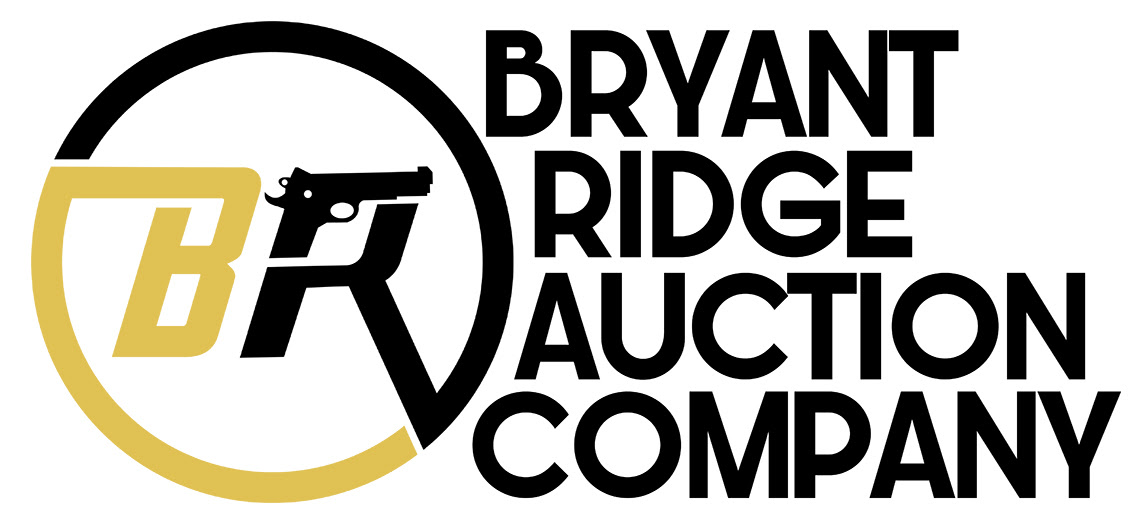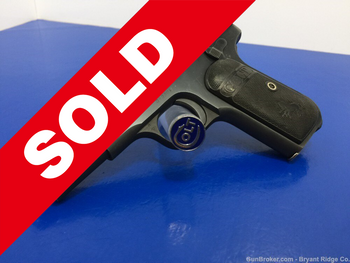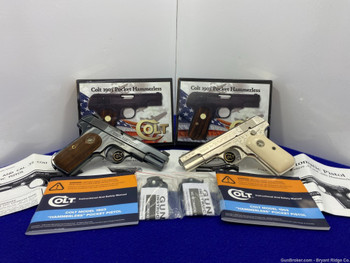Description

Item Description
Bryant Ridge Auction Company is pleased to present this incredible piece of American History for auction; this is the Colt 1903 Pocket General Officer's Pistol!
This lot of items include the Colt 1903 U.S. Property marked General Officer's pistol that was issued to MAJOR GENERAL ROBERT S. MOORE, along with his issue holsters, belt, General Officer's buckle, U.S. Army "Ike" dress jacket, and hat. The set also includes a hand-carved wooden storage box with the initials "RSM" on the lid, along with the original Army-issued "Certificate of Ownership" and accompanying letter, duplicate Department of Defense property release documents, and extra documentation summarizing Moore's
military career.
This lot of items include the Colt 1903 U.S. Property marked General Officer's pistol that was issued to MAJOR GENERAL ROBERT S. MOORE, along with his issue holsters, belt, General Officer's buckle, U.S. Army "Ike" dress jacket, and hat. The set also includes a hand-carved wooden storage box with the initials "RSM" on the lid, along with the original Army-issued "Certificate of Ownership" and accompanying letter, duplicate Department of Defense property release documents, and extra documentation summarizing Moore's
military career.
Major General Moore had an illustrious career in the US Army, beginning in 1917 during World War I. He worked his way up through the ranks and was eventually wounded during the Somme Offensive. After the war, he decided to make the Army his career and attended the Army finance school. In 1930, he was assigned to the U.S. Army Finance Office and eventually made Captain in 1934. He spent several years working in important Army budgeting jobs in Washington DC, and in 1940 he was promoted to the rank of Major.
Moore's expertise in finance was put to good use during World War II, where he was responsible for preparing the language of military appropriation bills and defending that language before the Bureau of the Budget and Congress. Congress appropriated $160 billion to the Army during the war, and Moore was also charged with ensuring that the entire sum could be spent legally through the obligation and expenditure process.
After the war, Moore participated in negotiating hundreds of millions of dollars in settlements with the military governments of Germany and Korea, and with the civilian governments of Austria and Czechoslovakia. In 1950, he was hired as a special assistant to the Comptroller of the Department of Defense and was promoted to brigadier general on October 5, 1950. He developed working friendships with congressional democrats and republicans alike and was known for his ability to analyze a problem and carry it into speedy execution of a workable solution.
Moore received his final promotion to major general on May 1, 1954. Three months later, he voluntarily retired from the Army on August 31, 1954, but was recalled to active duty at the request of Congress on September 7, 1954, and continued as special assistant to the Department of Defense comptroller for another 14 years. In 1961 he was described as a former sergeant major who “has participated in the spending of more money than any other person in U.S. military history.”
Moore completed 50 years of military service on November 13, 1967, an event memorialized by Senators John C. Stennis and Milton Young on the floor of the Senate. He has served every Secretary of Defense and every Comptroller of Defense since the creation of the Department of Defense. Moore retired permanently from the Defense Department in 1968 and was awarded the Distinguished Service Medal by Army Chief of Staff Harold K. Johnson. He passed away at his home in Washington, D.C. on January 27, 1978.
Aside from his military career, Moore was also a 50-year Master Mason and a member of the Shriners Almas Temple in Washington, D.C. He was also a member of the University Club of Washington, D.C., and the Army Navy Country Club in Arlington, Virginia.
As per the factory letter enclosed with this example, it was sold to the United States Government and shipped to the Transportation Officer at the Springfield Armory in Springfield, Massachusetts for the Commanding Officer on December 30, 1944, with Colt factory order #4711. The shipment consisted of a total of 1,583 guns.
Click here to view our other Live Auctions!
As per the factory letter enclosed with this example, it was sold to the United States Government and shipped to the Transportation Officer at the Springfield Armory in Springfield, Massachusetts for the Commanding Officer on December 30, 1944, with Colt factory order #4711. The shipment consisted of a total of 1,583 guns.
Click here to view our other Live Auctions!
SPECIFICATIONS:
Manufacturer: Colt
Model: 1903 Pocket General Officer's Pistol
Serial: 566958
Date of Manufacture: 1942
Caliber: .32 ACP
Finish: Parkerized
Barrel Length: 3 3/4"
Optics/Sights: Fixed
Stock/Grips: Checkered Walnut with Colt Medallions
Action: Semi-Automatic
Markings: Standard
Bryant Ridge's Analysis:
Robert Scurlark Moore (September 5, 1895 - January 27, 1978) was a Major General in the United States Army Finance Corps. He served as a military liaison officer to the Senate and House Appropriations Committees for almost 30 years. Despite the Army's refusal to promote him to the rank of general officer, Congress twice used appropriations bills to promote him.
Moore was the only American military officer to be promoted twice in appropriations bills, from colonel to brigadier general in 1950 and from brigadier general to major general in 1954. This was doubly unusual, as his promotions were initiated by Congress instead of the Defense Department and by the Appropriations Committees instead of the Armed Services Committees.
No one today thinks about the number of small pistols because so many options are available, but the variety was not so plentiful at one time. But one pistol in particular got the ball rolling for the pocket gun craze, and it’s been rolling on ever since the Colt Model 1903 Pocket Hammerless.
If you wanted to buy a handgun at the turn of the century that was small and concealable, your options were pretty limited. Most of the choices were revolvers; the venerable 1911 was not even a blueprint, and semi-automatic pistols were still in their infancy. John Browning, however, had designed a new semi-auto pistol around the fairly new .32 ACP cartridge. The new gun was dubbed the Colt Model 1903 Pocket Hammerless, or behind closed doors at the plant, the Hammerless Model M. Although the name was misleading, the gun did have a hammer, but it was concealed inside the slide. This gave the 1903 Colt the ability to be carried in a pocket without worrying about it getting snagged. Offered in blue or a nickel finish, the first Colt 1903s came with hard rubber grips and later wore wood grips with a Colt medallion.
The early Colt 1903 had a four-inch barrel, then later a 3.75-inch barrel, and various barrel bushings throughout their production, the earliest being separate and later integral. The pistol was 6.75 inches long, 4.375 inches tall, and just a scant 7/8 inch wide. Compare the Colt 1903 with the Glock 43, which is 6.25 inches long, 4.25 inches tall, and one inch wide, and the Glock 43 was designed for concealed carry in every way, shape, and form. While the .32 ACP is no powerhouse by today’s standards, you must remember that none of the cartridges we take for granted today were available. The 9mm was only first being experimented with in Europe; the .45 ACP wouldn’t be seen until 1905, and the only .40-caliber rounds were in revolvers. The .32 ACP had a 71-grain FMJ that was listed as having a muzzle velocity of 900 fps, and the Colt 1903 had a magazine capacity of eight rounds, giving you a total of nine with one in the chamber. The magazine release was a heel style, typical of the day, especially in Europe. Like many of John Browning’s other designs, the Colt 1903 proved well ahead of its time. It had thumb and grip safety, which would be popular on other Colt pistols.
The pistol became an instant hit with anyone who felt the need to carry a gun, from cop to crook alike. They issued handguns to several police agencies in various parts of the country. Soon, there was clamor for a more powerful version, so Colt created the 1908 Pocket Hammerless (not to be confused with the 1908 Vest Pocket), which was essentially the same gun but in the new .380 ACP. The Colt 1903, though, was still popular for decades, even after the 1908 debut, and during the production run, the 1903 was by far much more popular. More than 770,000 of both models were produced, but only 138,000 were Model 1908 Pocket Hammerless pistols. The 1903 found a home in various parts of the world. The British bought several for use in Ireland in 1921. Japanese officers preferred them to their issued handguns. The British again received more 1903s before World War II as part of the Lend-Lease program.
In addition to other governments, the 1903 and the 1908 Pocket Hammerless models found their way into the US Military. Known as the General Officer Model pistol, they were issued to officers carrying a sidearm but didn’t need the heft and weight of a 1911 Colt. There were 4,000 issued, and of those, 2,500 were 1903 versions. These guns were parkerized, but a few were blued and had the US Property markings on the right side of the frame. Some more famous names were used in 1903, including General Douglas MacArthur. The Office of Strategic Services also preferred to issue the 1903 over the 1908. The General Officers Model was issued until the 1970s before being phased out. For those out there who have a hankering for these guns but, for some reason, don’t want an “old” gun, Colt is now offering the 1903 Pocket Hammerless once again. Colt has teamed up with the U.S. Armament Corporation and is producing the 1903 General Officers Model, which looks identical to the same gun made fifty years ago.
The Colt 1903 Pocket Hammerless was an innovative handgun when John Browning designed it well over a century ago. It started the trend of small-frame concealable handguns that could be carried reliably and safely, and no matter where the trend goes, we all know where to look back to see where it began.
Contents:
Up for auction is a Colt Model 1903 .32 "Pocket Hammerless" pistol issued to General Moore on January 29, 1965. The pistol is in excellent condition and comes with one Parkerized factory magazine, an unmarked kraft box, a Colt instruction sheet, and a cleaning rod. It also includes the General's issue black leather holsters with their original boxes, a black leather belt and General Officer's belt buckle, General Moore's Army dress jacket, cap, three 8x10" glossy photos, and all the documents shown in the photos.
Return Policy:
We gladly offer a 3 day unfired inspection policy from the time that the firearm is delivered to your FFL. Refunds are available for all qualifying orders.
Model: 1903 Pocket General Officer's Pistol
Serial: 566958
Date of Manufacture: 1942
Caliber: .32 ACP
Finish: Parkerized
Barrel Length: 3 3/4"
Optics/Sights: Fixed
Stock/Grips: Checkered Walnut with Colt Medallions
Action: Semi-Automatic
Markings: Standard
Bryant Ridge's Analysis:
Robert Scurlark Moore (September 5, 1895 - January 27, 1978) was a Major General in the United States Army Finance Corps. He served as a military liaison officer to the Senate and House Appropriations Committees for almost 30 years. Despite the Army's refusal to promote him to the rank of general officer, Congress twice used appropriations bills to promote him.
Moore was the only American military officer to be promoted twice in appropriations bills, from colonel to brigadier general in 1950 and from brigadier general to major general in 1954. This was doubly unusual, as his promotions were initiated by Congress instead of the Defense Department and by the Appropriations Committees instead of the Armed Services Committees.
No one today thinks about the number of small pistols because so many options are available, but the variety was not so plentiful at one time. But one pistol in particular got the ball rolling for the pocket gun craze, and it’s been rolling on ever since the Colt Model 1903 Pocket Hammerless.
If you wanted to buy a handgun at the turn of the century that was small and concealable, your options were pretty limited. Most of the choices were revolvers; the venerable 1911 was not even a blueprint, and semi-automatic pistols were still in their infancy. John Browning, however, had designed a new semi-auto pistol around the fairly new .32 ACP cartridge. The new gun was dubbed the Colt Model 1903 Pocket Hammerless, or behind closed doors at the plant, the Hammerless Model M. Although the name was misleading, the gun did have a hammer, but it was concealed inside the slide. This gave the 1903 Colt the ability to be carried in a pocket without worrying about it getting snagged. Offered in blue or a nickel finish, the first Colt 1903s came with hard rubber grips and later wore wood grips with a Colt medallion.
The early Colt 1903 had a four-inch barrel, then later a 3.75-inch barrel, and various barrel bushings throughout their production, the earliest being separate and later integral. The pistol was 6.75 inches long, 4.375 inches tall, and just a scant 7/8 inch wide. Compare the Colt 1903 with the Glock 43, which is 6.25 inches long, 4.25 inches tall, and one inch wide, and the Glock 43 was designed for concealed carry in every way, shape, and form. While the .32 ACP is no powerhouse by today’s standards, you must remember that none of the cartridges we take for granted today were available. The 9mm was only first being experimented with in Europe; the .45 ACP wouldn’t be seen until 1905, and the only .40-caliber rounds were in revolvers. The .32 ACP had a 71-grain FMJ that was listed as having a muzzle velocity of 900 fps, and the Colt 1903 had a magazine capacity of eight rounds, giving you a total of nine with one in the chamber. The magazine release was a heel style, typical of the day, especially in Europe. Like many of John Browning’s other designs, the Colt 1903 proved well ahead of its time. It had thumb and grip safety, which would be popular on other Colt pistols.
The pistol became an instant hit with anyone who felt the need to carry a gun, from cop to crook alike. They issued handguns to several police agencies in various parts of the country. Soon, there was clamor for a more powerful version, so Colt created the 1908 Pocket Hammerless (not to be confused with the 1908 Vest Pocket), which was essentially the same gun but in the new .380 ACP. The Colt 1903, though, was still popular for decades, even after the 1908 debut, and during the production run, the 1903 was by far much more popular. More than 770,000 of both models were produced, but only 138,000 were Model 1908 Pocket Hammerless pistols. The 1903 found a home in various parts of the world. The British bought several for use in Ireland in 1921. Japanese officers preferred them to their issued handguns. The British again received more 1903s before World War II as part of the Lend-Lease program.
In addition to other governments, the 1903 and the 1908 Pocket Hammerless models found their way into the US Military. Known as the General Officer Model pistol, they were issued to officers carrying a sidearm but didn’t need the heft and weight of a 1911 Colt. There were 4,000 issued, and of those, 2,500 were 1903 versions. These guns were parkerized, but a few were blued and had the US Property markings on the right side of the frame. Some more famous names were used in 1903, including General Douglas MacArthur. The Office of Strategic Services also preferred to issue the 1903 over the 1908. The General Officers Model was issued until the 1970s before being phased out. For those out there who have a hankering for these guns but, for some reason, don’t want an “old” gun, Colt is now offering the 1903 Pocket Hammerless once again. Colt has teamed up with the U.S. Armament Corporation and is producing the 1903 General Officers Model, which looks identical to the same gun made fifty years ago.
The Colt 1903 Pocket Hammerless was an innovative handgun when John Browning designed it well over a century ago. It started the trend of small-frame concealable handguns that could be carried reliably and safely, and no matter where the trend goes, we all know where to look back to see where it began.
Contents:
Up for auction is a Colt Model 1903 .32 "Pocket Hammerless" pistol issued to General Moore on January 29, 1965. The pistol is in excellent condition and comes with one Parkerized factory magazine, an unmarked kraft box, a Colt instruction sheet, and a cleaning rod. It also includes the General's issue black leather holsters with their original boxes, a black leather belt and General Officer's belt buckle, General Moore's Army dress jacket, cap, three 8x10" glossy photos, and all the documents shown in the photos.
Return Policy:
We gladly offer a 3 day unfired inspection policy from the time that the firearm is delivered to your FFL. Refunds are available for all qualifying orders.
Shipping Details
Handgun Standard Shipping $50.00
Long Gun Standard Shipping $70.00
Any orders placed with magazines that are not compliant with your state, county, or city regulations will not ship with your order.
















